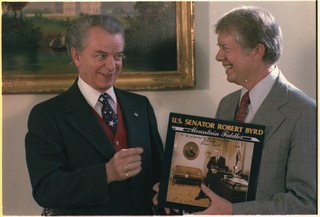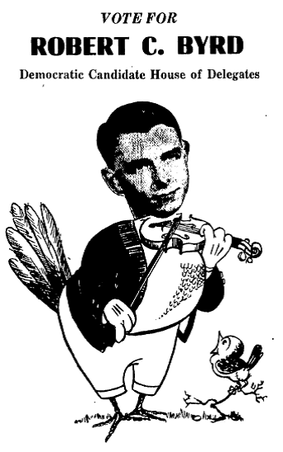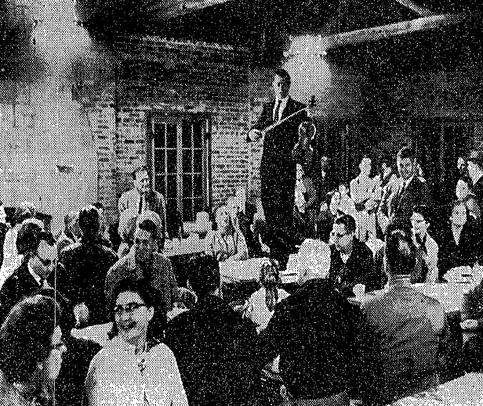|
Note: This post was previously listed under our "News from the Grey Box" blog series Part 2 of a 4 Part Series By Malorie Matos Senator Robert C. Byrd’s political career was a long and substantial one, spanning over 60 years, but the late senator’s impressive career may have never begun at all had it not been for an unlikely political tool: his fiddle. When 29 year-old Robert Byrd first considered a run for the West Virginia House of Delegates in 1946, his chances at victory seemed highly unlikely. Byrd was not an established politician, nor did he have any money or political connections. He was simply a small-town butcher from a poor coal-mining family with no way of effectively gaining support. It was not until an acquaintance of Byrd’s suggested he play his fiddle at rallies that his luck began to change. Byrd took to the campaign trail playing the traditional bluegrass songs that he knew from his childhood. Having grown up in the rural mountain town of Stotesbury, Byrd understood the important role that music played in building community relationships. He often went to small towns where residents did not trust politicians and were uninterested in what they had to say. His fiddle allowed him to reach out to those voters, gaining him the support he needed to strengthen his candidacy. Newspapers quickly took notice of Byrd’s unique campaign tactics, often calling him “Fiddlin’ Bob Byrd.” Ads in local papers announced appearances by Robert C. Byrd, saying, “Come and see the candidate who campaigns in the style of the old-fashioned South with his trusty fiddle and the bow!” Byrd continued to fiddle up support in his campaigns for West Virginia State Senate in 1950, the U.S House of Representatives in 1952 and for the U.S Senate race in 1958. His down-home persona appealed to the masses of West Virginia, keeping Byrd in every race even as opponents attacked him and the Democratic Party withheld their support. During his first U.S Senate race, Byrd garnered an enormous amount of national attention. The New York Times ran many articles about West Virginia’s U.S. Senate race, almost always mentioning Byrd’s “foot-stomping fiddling” and including photos of his entertaining rallies.  Byrd presents President Jimmy Carter with a copy of Mountain Fiddler, 1978 Byrd presents President Jimmy Carter with a copy of Mountain Fiddler, 1978 For the next few years, Byrd focused on working his way up in the Senate and primarily played the fiddle in his down time. Byrd occasionally broke out his old political tool during his endorsement appearances for the Kennedy-Johnson presidential ticket in 1960, but his fiddling otherwise took a backseat to the hot-topic issues on Capitol Hill. It was not until he announced his candidacy for President in 1976 that Senator Byrd’s fiddling reemerged in the public eye. Byrd once again used his musical skill to attract the attention of potential voters. He played at special events, including the African American Democratic Party dinner and southern political rallies. Byrd did not continue with his presidential campaign, instead choosing to pursue the position of Senate Majority Leader, but his characterization as “the fiddlin’ senator” had made a comeback during his brief time on the campaign trail. In the years following, Byrd made numerous public appearances playing tunes on his fiddle. He played at several Democratic Party functions, and he even played fiddle with a Panamanian orchestra on a senatorial trip to settle the controversy over the Panama Canal treaties. The senator also made the rounds at dozens of community festivals in West Virginia, playing with local string bands and maintaining the country-boy image that so endeared him to his voters. Senator Byrd continued to use the fiddle to boost his public image throughout the 1970’s. He appeared on the television show Hee Haw, played at the prestigious Grand Ole Opry, and finally solidified his unusual place in popular culture with the release of his bluegrass album, Mountain Fiddler. These appearances helped to soften the serious demeanor for which Byrd gained a reputation during his time in Congress. Whether he was gathering support on the campaign trail, entertaining fellow Democrats, or reaffirming his West Virginia heritage, Robert Byrd knew how to use his fiddle to his advantage. His ability to connect with constituents though music helped earn him the support that he needed to build a long-lasting political career.
Sources: Child of the Appalachian Coalfields by Robert C. Byrd New York Times article, Oct. 18, 1958 The Raleigh Register ad, July 28, 1946 The Last Great Senator: Robert C. Byrd’s Encounters with Eleven U.S. Presidents by David Corbin Comments are closed.
|
Welcome to the Byrd Center Blog! We share content here including research from our archival collections, articles from our director, and information on upcoming events.
Categories
All
Archives
July 2023
|
Our Mission: |
The Byrd Center advances representative democracy by promoting a better understanding of the United States Congress and the Constitution through programs and research that engage citizens.
|
Copyright © Robert C. Byrd Center for Congressional History and Education
|



 RSS Feed
RSS Feed
